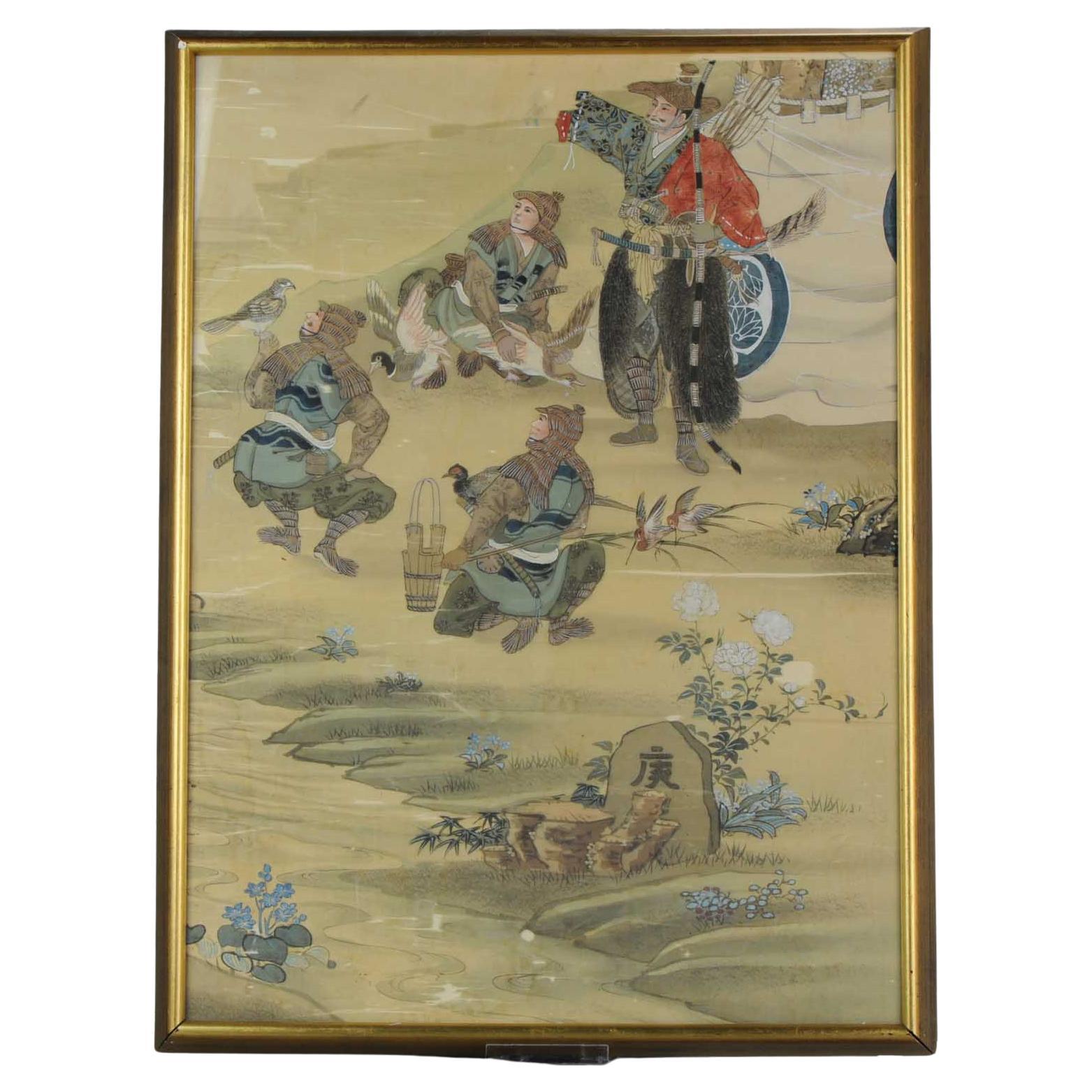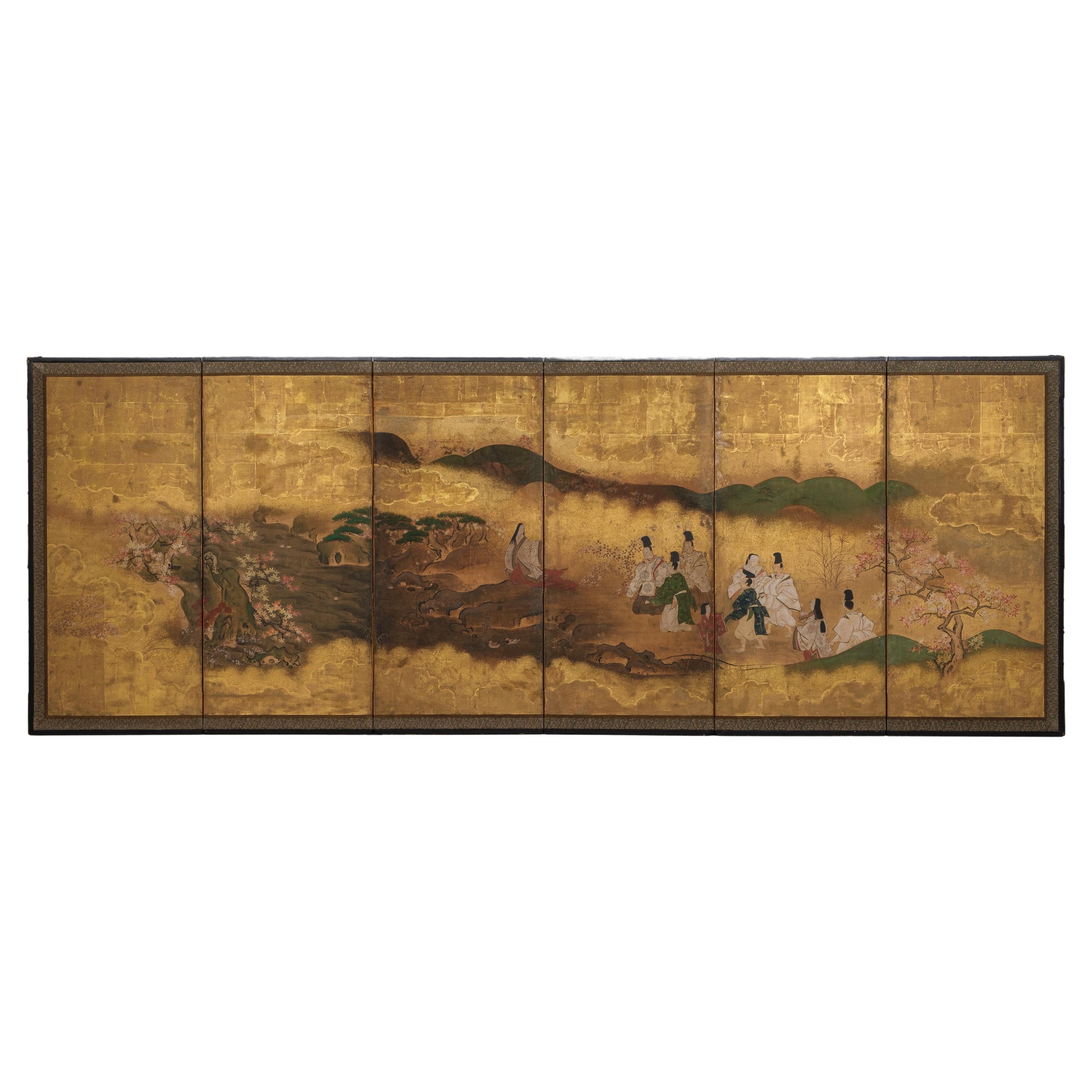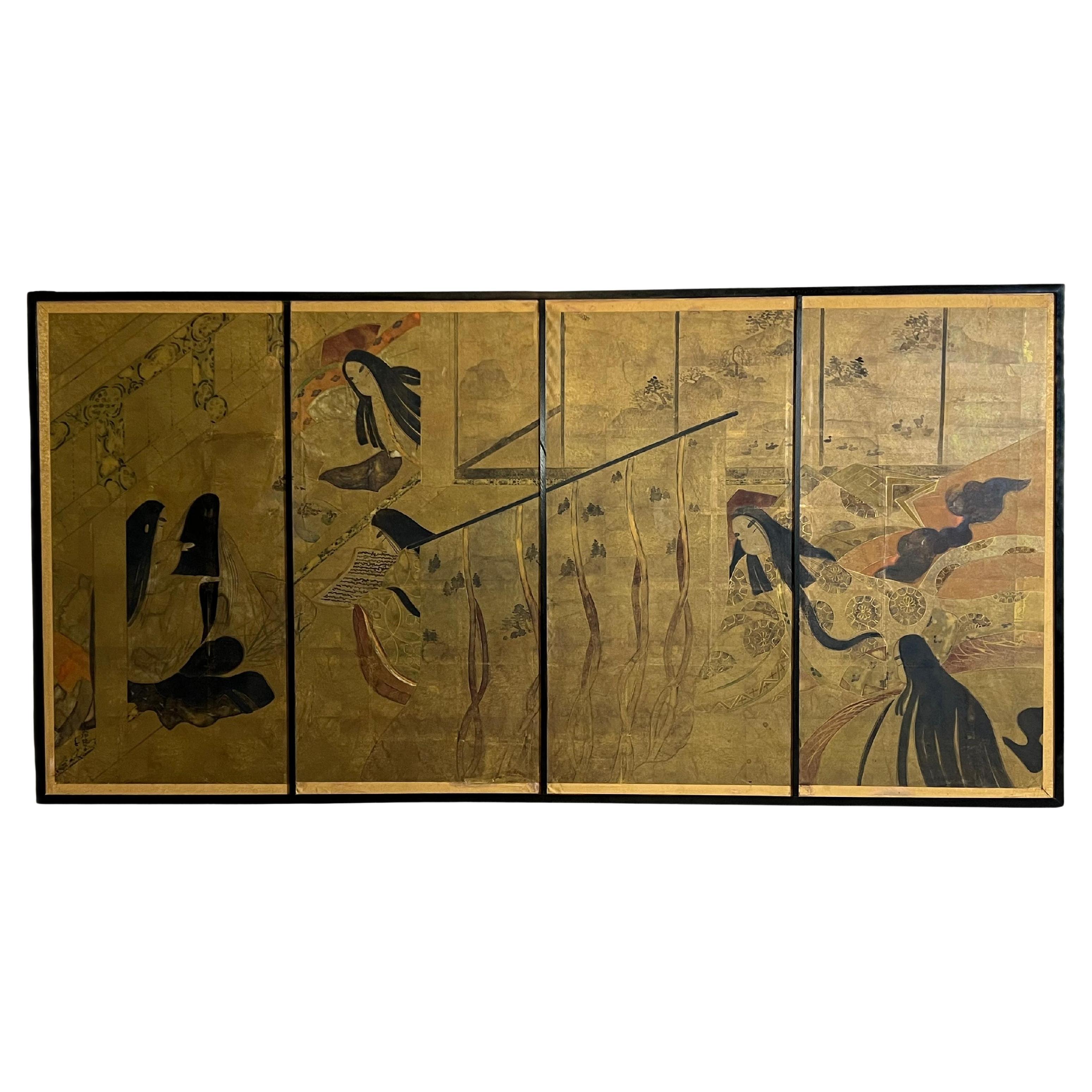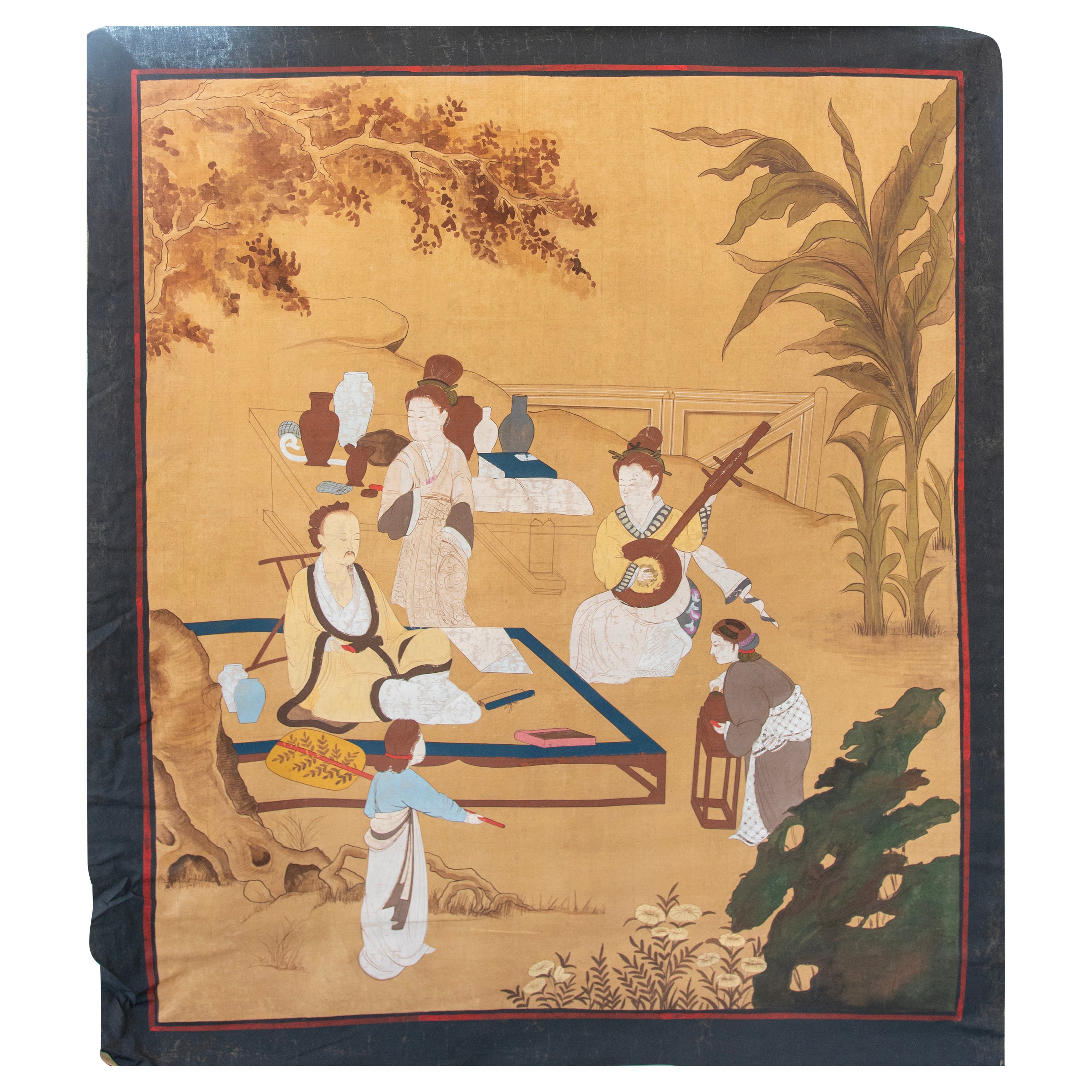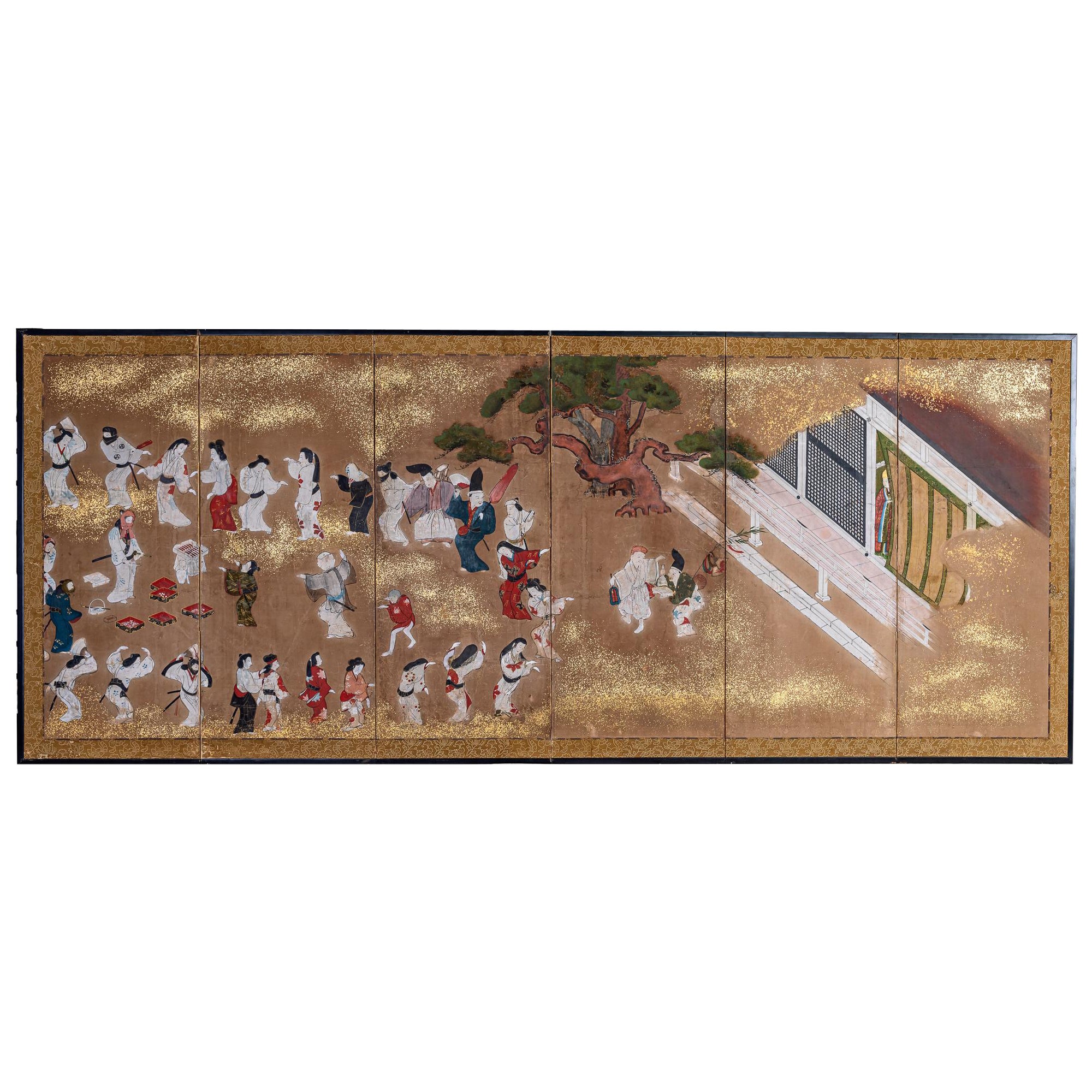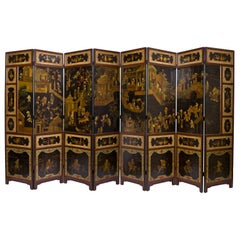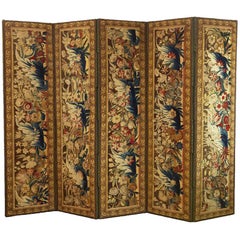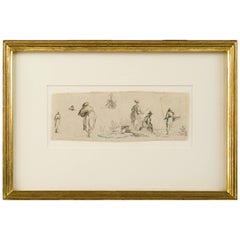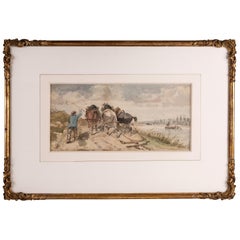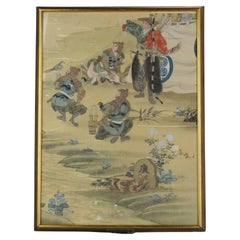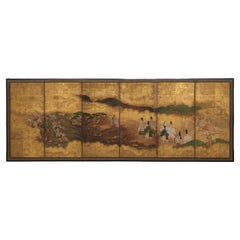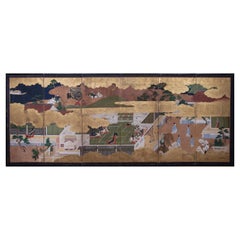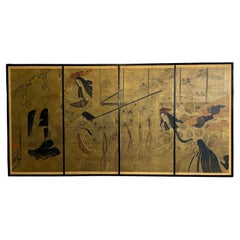Items Similar to Painting of a Tale of Genji Scene, Tosa School
Want more images or videos?
Request additional images or videos from the seller
1 of 7
Painting of a Tale of Genji Scene, Tosa School
$3,000
£2,267.63
€2,605.91
CA$4,177.48
A$4,647.28
CHF 2,436.16
MX$56,788.59
NOK 31,021.47
SEK 29,202.42
DKK 19,452.11
Shipping
Retrieving quote...The 1stDibs Promise:
Authenticity Guarantee,
Money-Back Guarantee,
24-Hour Cancellation
About the Item
Japanese 17th century school "Tale of Genji Scene" painting on paper, mounted to board. Nicely framed and boxed.
Professor Melissa McCormick at Harvard believes that it may be the work of Tosa Mitsuyoshi (1539-1613) or one of his disciples in the Tosa School. This painting is probably a leaf taken from an album of illustrations of the Tale of Genji. Such albums would typically include one painting for each of the fifty-four chapters of the Tale. The chapters can be quite long and complex, as many as a hundred pages in modern translation, but painterly tradition dictated which scenes were considered representative of each chapter and those scenes became iconic as they were depicted over and over. Our painting is an illustration of a scene in the thirteenth chapter, also known as the Akashi Chapter. It shows the protagonist Genji going on horseback for his first meeting with a woman known as “the Akashi lady.”
In the Akashi chapter, Genji’s father the Emperor has died and Genji’s older brother Suzaku, the son of their father’s primary wife, has now ascended the throne. Genji, who is notoriously promiscuous, has recently been discovered having an affair with one of Suzaku’s concubines. The resulting scandal has forced him into exile in a series of locales far away from the capital; a fate worse than death for aristocrats at the time. In the previous chapter he has spent a year on the desolate shore at Suma, near the modern city of Kobe. In the opening of the Akashi chapter, a great storm destroys Genji’s temporary residence at Suma and when the storm subsides a boat mysteriously appears ready to take him and his party a little further down the shore to the province of Akashi. Genji has previously heard rumors of the Governor of this province, a crusty old type who once served in high-ranking positions in the capital but has now come down in the world, sequestering himself in a large residence by the sea and taking the tonsure to become a priest. The old man’s great ambition is to make a good marriage for his daughter and thereby to restore the fortunes of his family at the center of power. As it happens, he is also a distant relative of Genji’s deceased mother. Various signs and omens point to the possibility that if Genji marries their daughter, known as “The Akashi Lady,” she will bear a child who will become an empress and give birth to a future emperor. This is exactly what happens in later chapters: the Akashi Lady, a woman of relatively humble birth finds herself catapulted into the highest reaches of the aristocracy, becoming the mother of an empress. The story of the rise of the Akashi family is one of the great “rags to riches” tales in classical Japanese literature. It is also the mechanism whereby the wrong that Genji’s mother suffers at the beginning of the Tale is set to right. While her son Genji will not become an emperor, he does become the grandfather of an emperor, thus reinscribing himself and his mother into the imperial line. This chapter, where Genji first meets the Akashi Lady, is thus a pivotal moment in the Tale.
In the scene depicted in our painting, Genji rides on horseback to the house where she is staying. It is a meeting that has been carefully arranged by her ambitious father, “the old priest.” Genji is intrigued by rumors of the Akashi Lady’s beauty and her skill as a poet and a musician. But, characteristically, he is also, simultaneously, pining for another woman, the Lady Murasaki, whom he has left behind in the capital. As the critic Raymond Mortimer puts it in his 1925 review of the first translation of the Tale, “During the course of this [first] volume at least seven different affairs rouse in [Genji] serious and delicate emotion. Is there any other novel which recognizes the possibility, and indeed the commonness, of such an experience?”
- Attributed to:Tosa School (Artist)
- Dimensions:Height: 18.5 in (46.99 cm)Width: 16.6 in (42.17 cm)Depth: 1.5 in (3.81 cm)
- Style:Japonisme (In the Style Of)
- Materials and Techniques:
- Place of Origin:
- Period:
- Date of Manufacture:17th Century
- Condition:Wear consistent with age and use.
- Seller Location:Kittery Point, ME
- Reference Number:Seller: 21661stDibs: LU837635067072
About the Seller
5.0
Gold Seller
Premium sellers maintaining a 4.3+ rating and 24-hour response times
Established in 2004
1stDibs seller since 2007
81 sales on 1stDibs
Typical response time: 2 hours
- ShippingRetrieving quote...Shipping from: Kittery Point, ME
- Return Policy
Authenticity Guarantee
In the unlikely event there’s an issue with an item’s authenticity, contact us within 1 year for a full refund. DetailsMoney-Back Guarantee
If your item is not as described, is damaged in transit, or does not arrive, contact us within 7 days for a full refund. Details24-Hour Cancellation
You have a 24-hour grace period in which to reconsider your purchase, with no questions asked.Vetted Professional Sellers
Our world-class sellers must adhere to strict standards for service and quality, maintaining the integrity of our listings.Price-Match Guarantee
If you find that a seller listed the same item for a lower price elsewhere, we’ll match it.Trusted Global Delivery
Our best-in-class carrier network provides specialized shipping options worldwide, including custom delivery.More From This Seller
View AllChinese Black and Polychrome Lacquered Eight-Panel Screen
Located in Kittery Point, ME
Depicting a continuous scene of figures at leisure within a riverscape with rocky hills beyond and with smaller panels of scholars' objects‚ flowering trees and mythological beasts a...
Category
Antique Early 18th Century Chinese Chinoiserie Screens and Room Dividers
Materials
Lacquer
Price Upon Request
A Flemish Tapestry Five-Panel Screen
Located in Kittery Point, ME
Each tapestry upholstered panel incorporating Flemish vertical tapestry fragments woven with foliate blossoms and sprays set in a later surround wove...
Category
Antique Late 17th Century Belgian Screens and Room Dividers
Materials
Tapestry
$10,280 Sale Price
20% Off
Drawing Attributed to Jean-Baptiste Pillement
By Jean-Baptiste Pillement
Located in Kittery Point, ME
Two-faced drawing.
Studies of characters and harbor scene.
With an inscription stating it is from the sketchbook in the collection of Dr. Manuel de Espirito Santo in Lisbon.
Ink a...
Category
Antique Late 18th Century French Neoclassical Drawings
Materials
Paper
$2,200 Sale Price
20% Off
Watercolor by Richard Beavis, 19th Century British School
Located in Kittery Point, ME
Richard Beavis (British, 1824-1896)
Near Arles on the Rhone
Initialed and titled lower left.
Ink and watercolor on paper/board.
With an old attribution to Bonnington.
Sight size: 6 x 13 in. The dimension given otherwise includes the frame.
Framed in a charming late 19th century frame.
Best known for his rural landscapes, the British painter Richard Beavis populated his scenes with picturesque grazing cattle and people hard at work as well illustrated in our watercolor.
Provenance: The estate of Sir Edwin A.G. Manton (1909-2005) a driving force in the creation of the American International Group (AIG), a collector of paintings by John Constable...
Category
Antique Late 19th Century English Victorian Drawings
Materials
Paper
$1,120 Sale Price
20% Off
Watercolor signed by the Reverend James Bourne (1773-1854)
Located in Kittery Point, ME
St Clair, Isles of Wight (as situated at back of drawing).
James Bourne was a known landscape artist specialized in watercolors who exposed his works at the Royal Academy in the earl...
Category
Antique 19th Century English Paintings
Materials
Paper
$760 Sale Price
20% Off
Large Drawing in the Style of Guardi, Italian School
Located in Kittery Point, ME
Venetian Capriccio, after Francesco Guardi (Italian, 1712-1793)
Unsigned, with a label from Wandenberg Freres (Paris) affixed to the back of the mat.
Category
Antique 19th Century Italian Rococo Drawings
Materials
Ink
$1,920 Sale Price
20% Off
You May Also Like
Samurai Japanese Scene Meij Period Painting Japan Artist, 19/20th Century
Located in Amsterdam, Noord Holland
Very nice painting with Japanese Samurai Scene. 19/20th century
Additional information:
Material: Wood / Bamboo
Primary Material: Paper
Region of Origin: Japan
Condition: Some minim...
Category
20th Century Japanese Meiji Paintings
Materials
Paper
Mid-size 6-panel byôbu 屏風 with a scene from The Tale of Genji
Located in Amsterdam, NL
A refined medium-sized six-panel byôbu (folding screen) showcasing a classical autumn court scene from chapter 7 of The Tale of Genji (Genji Monogatari), titled Momiji no Ga (The Aut...
Category
Antique 17th Century Japanese Paintings and Screens
Materials
Metal, Gold Leaf
Important Japanese six-fold screen depicting The Tale of The Genji, 17th century
Located in Amsterdam, NL
An important Japanese six-fold screen, depicting episodes from The Tale of The Genji
Edo period, 17th century
Ink and colour on gilded paper, H. 155 x W. 380 cm
The Tale of Genji...
Category
Antique 17th Century Japanese Edo Paintings and Screens
Materials
Paint, Paper
Large Painting of a Japanese Scene After the Tale of Genji
Located in Pasadena, CA
This painting is an illustration of the classic Japanese novel, "The Tale of Genji," written by Murasaki Shikibu. It captures the aristocratic atmosp...
Category
Antique 19th Century Japanese Han Paintings
Materials
Paper, Paint
$2,200 Sale Price
31% Off
Japanese Folk Scene Playing Instruments Painted on Canvas
Located in Marbella, ES
Japanese Folk Scene Playing Instruments Painted on Canvas
Category
Late 20th Century Asian Paintings
Materials
Fabric
Japanese Six Panel Screen: Tosa School Painting of Theatre Scene
Located in Hudson, NY
with thought to be Izumo no Okuni (1578-1613). Mineral pigments and gold dust on mulberry paper with silk brocade border.
Category
Antique 18th Century Japanese Paintings and Screens
Materials
Gold
More Ways To Browse
Old Man Of The Sea
Priest Japanese
Japanese Throne
Tale Of Genji
Genji Painting
Tosa School
Japanese Tosa School
Japanese Emperor And Empress
Mens Wool Swimsuit
Mil Mascaras
Nalle Werner
Patria Watch
Randy Harter
Retro Flying Wall Ducks
Robin Vaccarino
Soicher Marin
Wedgwood Fairyland Lustre Plaque
Adolfo Arenas Alonso
